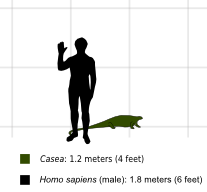Casea
Casea is a genus of herbivorous caseid synapsids that lived during the late Lower Permian (Kungurian) in what is now Texas, United States. The genus is only represented by its type species, Casea broilii, named by Samuel Wendell Williston in 1910.[1] The species is represented by a skull associated with a skeleton (the holotype FMNH UC 656), a second skull (FMNH UC 698), a partial skull with a better preserved dentition than that of the preceding skulls (FMNH UC 1011), and several incomplete postcranial skeletons.[2] Three other Casea species were later erected, but these are considered today to be invalid or belonging to different genera.[3][4][5] Casea was a small animal with a length of about 1.20 m and a weight of around 20 kg.[6][7]
The skull, relatively small compared to the size of the body, shows the typical morphology of the caseids with a snout tilted forward, a skull roof decorated with many small pits, and a large pineal opening. The external nares are smaller than those of more derived caseids. The orbits are very large and are directed outwards and slightly forward. In dorsal view, the end of the snout is wider and more rounded than that of the more derived caseidae.[8][6][9] The palate is broad and plate-like. A narrow interpterygoid vacuity divides the posterior portions of the palate at the midline.[3] The bones of the palate are almost completely covered with teeth, the largest being on the margins, and the smallest in the center of the palate. The upper jaws had two teeth on each premaxilla and 11 teeth on each maxilla. 12 teeth were present on each hemimandible, some being positioned on the coronoid eminence, a primitive character. The first six teeth of the upper and lower jaws are very strong, conical, almost circular at their base, but more rounded at the apex, and somewhat compressed medio-laterally. Those of the upper jaws are vertical, while the first six teeth of the mandible are directed outward and forward at an angle of forty degrees or more. Few details are visible on the teeth of the holotype FMNH UC 656 and paratype FMNH UC 698 due to very rough preparation of these specimens. However, more careful preparation of the maxillary teeth of the specimen FMNH UC 1011 revealed the presence of tricuspid crowns.[8][6][2]



